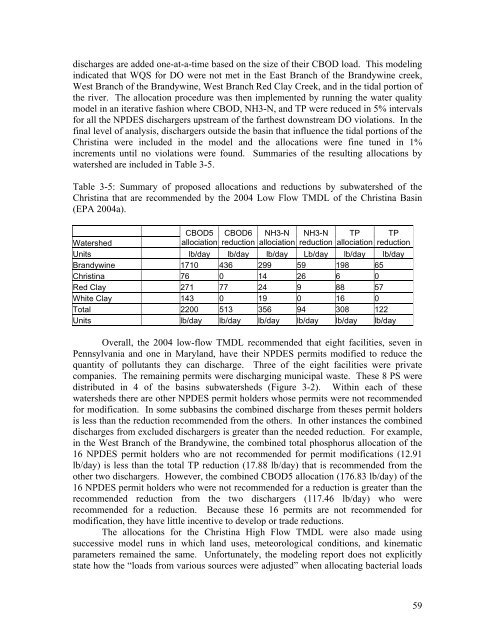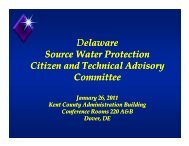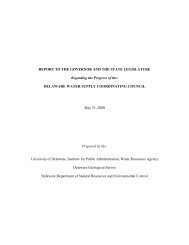Water Quality Trading in the Lower Delaware River Basin: A ...
Water Quality Trading in the Lower Delaware River Basin: A ...
Water Quality Trading in the Lower Delaware River Basin: A ...
You also want an ePaper? Increase the reach of your titles
YUMPU automatically turns print PDFs into web optimized ePapers that Google loves.
discharges are added one-at-a-time based on <strong>the</strong> size of <strong>the</strong>ir CBOD load. This model<strong>in</strong>g<br />
<strong>in</strong>dicated that WQS for DO were not met <strong>in</strong> <strong>the</strong> East Branch of <strong>the</strong> Brandyw<strong>in</strong>e creek,<br />
West Branch of <strong>the</strong> Brandyw<strong>in</strong>e, West Branch Red Clay Creek, and <strong>in</strong> <strong>the</strong> tidal portion of<br />
<strong>the</strong> river. The allocation procedure was <strong>the</strong>n implemented by runn<strong>in</strong>g <strong>the</strong> water quality<br />
model <strong>in</strong> an iterative fashion where CBOD, NH3-N, and TP were reduced <strong>in</strong> 5% <strong>in</strong>tervals<br />
for all <strong>the</strong> NPDES dischargers upstream of <strong>the</strong> far<strong>the</strong>st downstream DO violations. In <strong>the</strong><br />
f<strong>in</strong>al level of analysis, dischargers outside <strong>the</strong> bas<strong>in</strong> that <strong>in</strong>fluence <strong>the</strong> tidal portions of <strong>the</strong><br />
Christ<strong>in</strong>a were <strong>in</strong>cluded <strong>in</strong> <strong>the</strong> model and <strong>the</strong> allocations were f<strong>in</strong>e tuned <strong>in</strong> 1%<br />
<strong>in</strong>crements until no violations were found. Summaries of <strong>the</strong> result<strong>in</strong>g allocations by<br />
watershed are <strong>in</strong>cluded <strong>in</strong> Table 3-5.<br />
Table 3-5: Summary of proposed allocations and reductions by subwatershed of <strong>the</strong><br />
Christ<strong>in</strong>a that are recommended by <strong>the</strong> 2004 Low Flow TMDL of <strong>the</strong> Christ<strong>in</strong>a Bas<strong>in</strong><br />
(EPA 2004a).<br />
<strong>Water</strong>shed<br />
CBOD5<br />
allociation<br />
CBOD6<br />
reduction<br />
NH3-N<br />
allociation<br />
NH3-N<br />
reduction<br />
TP<br />
allociation<br />
TP<br />
reduction<br />
Units lb/day lb/day lb/day Lb/day lb/day lb/day<br />
Brandyw<strong>in</strong>e 1710 436 299 59 198 65<br />
Christ<strong>in</strong>a 76 0 14 26 6 0<br />
Red Clay 271 77 24 9 88 57<br />
White Clay 143 0 19 0 16 0<br />
Total 2200 513 356 94 308 122<br />
Units lb/day lb/day lb/day lb/day lb/day lb/day<br />
Overall, <strong>the</strong> 2004 low-flow TMDL recommended that eight facilities, seven <strong>in</strong><br />
Pennsylvania and one <strong>in</strong> Maryland, have <strong>the</strong>ir NPDES permits modified to reduce <strong>the</strong><br />
quantity of pollutants <strong>the</strong>y can discharge. Three of <strong>the</strong> eight facilities were private<br />
companies. The rema<strong>in</strong><strong>in</strong>g permits were discharg<strong>in</strong>g municipal waste. These 8 PS were<br />
distributed <strong>in</strong> 4 of <strong>the</strong> bas<strong>in</strong>s subwatersheds (Figure 3-2). With<strong>in</strong> each of <strong>the</strong>se<br />
watersheds <strong>the</strong>re are o<strong>the</strong>r NPDES permit holders whose permits were not recommended<br />
for modification. In some subbas<strong>in</strong>s <strong>the</strong> comb<strong>in</strong>ed discharge from <strong>the</strong>ses permit holders<br />
is less than <strong>the</strong> reduction recommended from <strong>the</strong> o<strong>the</strong>rs. In o<strong>the</strong>r <strong>in</strong>stances <strong>the</strong> comb<strong>in</strong>ed<br />
discharges from excluded dischargers is greater than <strong>the</strong> needed reduction. For example,<br />
<strong>in</strong> <strong>the</strong> West Branch of <strong>the</strong> Brandyw<strong>in</strong>e, <strong>the</strong> comb<strong>in</strong>ed total phosphorus allocation of <strong>the</strong><br />
16 NPDES permit holders who are not recommended for permit modifications (12.91<br />
lb/day) is less than <strong>the</strong> total TP reduction (17.88 lb/day) that is recommended from <strong>the</strong><br />
o<strong>the</strong>r two dischargers. However, <strong>the</strong> comb<strong>in</strong>ed CBOD5 allocation (176.83 lb/day) of <strong>the</strong><br />
16 NPDES permit holders who were not recommended for a reduction is greater than <strong>the</strong><br />
recommended reduction from <strong>the</strong> two dischargers (117.46 lb/day) who were<br />
recommended for a reduction. Because <strong>the</strong>se 16 permits are not recommended for<br />
modification, <strong>the</strong>y have little <strong>in</strong>centive to develop or trade reductions.<br />
The allocations for <strong>the</strong> Christ<strong>in</strong>a High Flow TMDL were also made us<strong>in</strong>g<br />
successive model runs <strong>in</strong> which land uses, meteorological conditions, and k<strong>in</strong>ematic<br />
parameters rema<strong>in</strong>ed <strong>the</strong> same. Unfortunately, <strong>the</strong> model<strong>in</strong>g report does not explicitly<br />
state how <strong>the</strong> “loads from various sources were adjusted” when allocat<strong>in</strong>g bacterial loads<br />
59




